How to Build a Retaining Wall with Landscape Timbers
- February 1, 2024
- 0 comment
Constructing a retaining wall using landscape timbers offers both aesthetic and functional benefits to any garden space. Such a project not only elevates the visual appeal of your outdoor area but also serves as an effective measure against soil erosion, safeguarding the integrity of your landscape. Embarking on this endeavor requires a selection of appropriate materials and tools, alongside a willingness to invest effort into the task.

With careful planning and dedication, it’s entirely feasible to build a timber retaining wall that is both sturdy and visually appealing. This comprehensive guide aims to navigate you through each phase of the process, ensuring you’re well-equipped with the knowledge needed for successful planning, preparation, and execution, ultimately leading to the creation of a functional and aesthetically pleasing outdoor feature.
Preparing for Your Timber Wall
As you gear up to construct a retaining wall using landscape timbers, it’s important to have a comprehensive checklist of vital materials and tools at the ready. This preparatory step is crucial to ensure that you have everything needed for a smooth and efficient building process. The list below outlines the key components and equipment required to bring your timber retaining wall project to fruition:
Materials
- Landscape timbers
- Rebar (for anchoring the timbers)
- Gravel (for the foundation layer)
- Drain rock (for behind the wall to ensure proper drainage)
- Wood screws (for securing the timbers together)
Tools
- Shovel (for digging the trench)
- Level (to ensure the timbers are properly aligned)
- Drill (for making holes in the timbers for rebar and driving the screws)
- Hammer (for driving the rebar into the ground)
- Tape measure (for accurate measurements during planning and construction)
Planning Your Wall
Before embarking on the construction of your timber retaining wall, it’s essential to meticulously outline the designated area where the wall will be erected. Utilizing stakes and string for this task serves a dual purpose; it aids in visualizing the scope and layout of the project, providing a clear blueprint to work from. Additionally, this preliminary step plays a crucial role in confirming that the construction takes place in the correct location, aligning with your landscaping plans and avoiding any potential conflicts with underground utilities or property boundaries.
This careful planning and preparation set the foundation for a successful build, ensuring that the retaining wall not only meets your aesthetic and functional needs but also complies with local regulations and guidelines.
Step-by-Step Guide to Building Your Timber Retaining Wall
Marking the Area
The first crucial step in constructing a timber retaining wall is to accurately mark out the area where the wall will be built. This process involves strategically placing stakes at the intended corners of the wall and then connecting them with string to outline the wall’s perimeter. This preliminary setup acts as a vital visual guide, not only helping to envisage how the wall will integrate with the existing landscape but also ensuring that the construction aligns precisely with your planned design specifications.
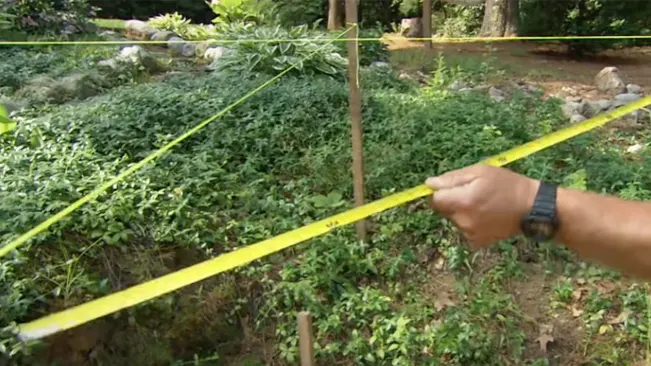
It’s a methodical approach that aids in avoiding potential obstacles and ensures that the wall is constructed in the correct location, harmonizing with the surrounding landscape features and adhering to any design constraints. This careful planning sets the foundation for a successful build, ensuring that the retaining wall fulfills its intended aesthetic and functional roles within your outdoor space.
Digging the Trench
The next step involves excavating a trench that serves as the foundational bed for your retaining wall. A depth of about one foot and a width of 8-10 inches are typically sufficient, tailored to snugly fit the dimensions of the landscape timbers you’ve chosen, ensuring a snug and secure base.
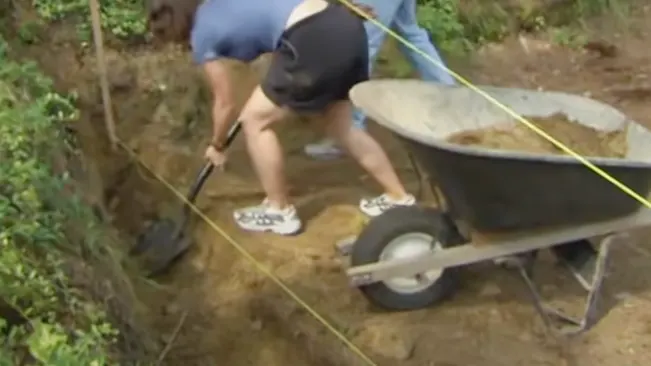
Laying the Foundation
Creating a stable foundation is crucial, achieved by filling the trench with a 6-inch layer of gravel. This layer is then compacted firmly, establishing a solid and level base that aids in drainage and provides a sturdy groundwork for the timbers.
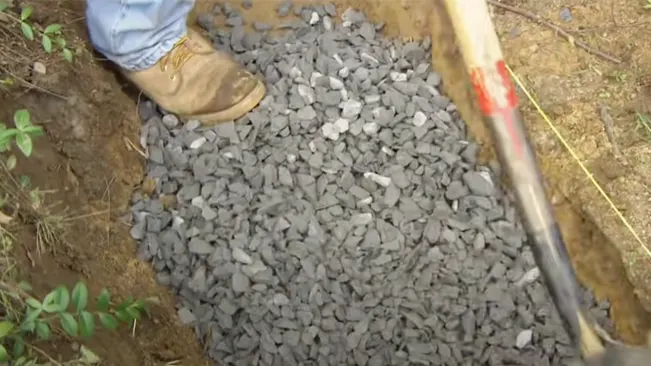
Installing the First Layer of Timbers
The construction phase begins with the placement of the first layer of timbers within the prepared trench. It’s vital to ensure this initial layer is perfectly level, as it sets the precedent for the alignment and stability of subsequent layers.
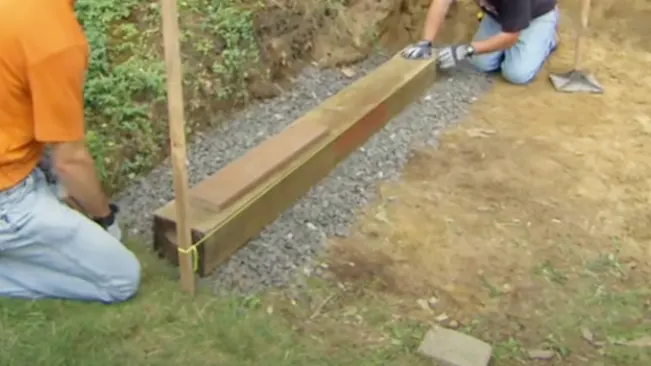
Securing Timbers with Rebar
To anchor the timbers securely in place, drill three evenly spaced holes through each timber and insert rebar. Driving the rebar deep into the ground through these holes stabilizes the timbers, preventing shifting and providing a strong foundation for the wall.

Adding Subsequent Layers
Building upon the first layer, additional timbers are stacked, with each new layer offset from the one below to enhance structural integrity. Wood screws are used at intervals to fasten each layer to the preceding one, ensuring a cohesive and robust retaining wall.
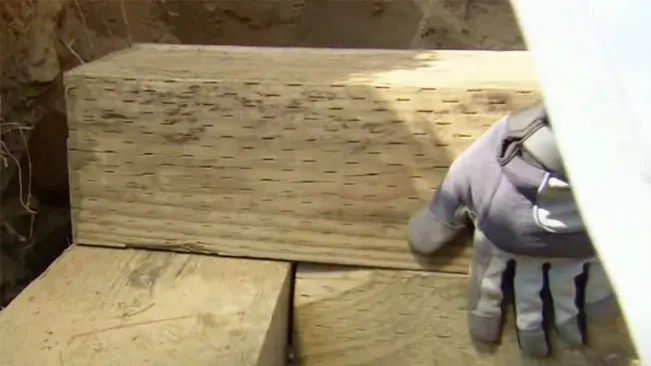
Ensuring Proper Drainage
Adequate drainage is essential to safeguard the wall against water pressure and potential damage. Installing a layer of drain rock directly behind the wall facilitates water flow away from the structure, mitigating the risk of water-related issues.

Key Elements of a Durable Timber Retaining Wall
To ensure the longevity and effectiveness of a timber retaining wall, certain critical elements must be integrated into its design and construction. These include a comprehensive drainage system to prevent moisture buildup that could lead to wood deterioration, a solid foundation made of gravel to provide stability, and a height that is sufficient for its intended function, whether for beautifying the landscape or preventing soil erosion. Incorporating these key components will help the retaining wall withstand environmental stresses and maintain its structural integrity over time.
Common Mistakes to Avoid
To ensure the success and longevity of your timber retaining wall, it’s crucial to address common pitfalls that can compromise its integrity and functionality. Here are key aspects to consider:
- Implementing sufficient drainage is critical to prevent water accumulation behind the wall, which can lead to increased pressure and potential structural failure. Incorporate a drainage system, such as a layer of drain rock and a perforated drain pipe, to facilitate water flow away from the wall.
- The foundation of your retaining wall relies on the depth of the trench you dig. A trench that’s not deep enough may not provide the necessary stability, especially in areas with loose soil or heavy rainfall. Aim for at least a foot deep trench to accommodate the base layer of gravel and the first row of timbers securely.
- Building a retaining wall might seem straightforward, but it involves careful planning, precise execution, and an understanding of structural principles. Don’t underestimate the tasks involved, such as selecting the right materials, ensuring structural integrity, and accounting for environmental factors. Consider consulting with professionals or seeking expert advice if the project’s scope is beyond your expertise.
By paying close attention to these critical aspects, you can avoid common mistakes and ensure your timber retaining wall is both durable and effective.
When to Consider Professional Help
Tackling a timber retaining wall project can be challenging without the right experience or resources. Opting for professional help, like that offered by New Life Rockeries, can be a smart move. Their expertise ensures the construction of a durable and attractive retaining wall, tailored to your needs, saving you time and potential complications of DIY efforts.
Related Topics
Conclusion
Building a timber retaining wall is a fulfilling DIY project that can beautify and add functionality to your landscape, such as preventing soil erosion and creating distinct garden sections. It demands careful planning and execution, from choosing the right materials to ensuring structural integrity. While it’s a project many can undertake, recognizing the need for professional assistance is crucial when facing complex challenges or when the project’s demands exceed personal expertise. Consulting with professionals can ensure the retaining wall is built safely and effectively, blending seamlessly with your outdoor space.
FAQs
- Can I build a timber retaining wall myself?
Yes, building a timber retaining wall is a doable DIY project if you have basic construction knowledge and access to the right tools and materials. It’s important to research and plan thoroughly before starting. - How deep should the trench be for my timber wall?
The trench for a timber retaining wall should be about a foot deep to provide a stable foundation and accommodate a base layer of gravel for drainage. - What kind of timber is best for a retaining wall?
Pressure-treated timbers are recommended for retaining walls due to their resistance to decay and pests, ensuring durability. - How do I ensure proper drainage behind my timber wall?
To ensure proper drainage, install a layer of drain rock behind the wall and consider a perforated drain pipe at the base for taller walls to prevent water buildup. - When should I consider hiring a professional?
Consider hiring a professional if the project is large or complex, if you’re unsure about the process, lack the necessary tools, or if the wall requires engineering and permits. - How long does it take to build a timber retaining wall?
The time it takes to build a timber retaining wall can vary greatly depending on the size and complexity of the wall, as well as your skill level. A small, simple wall might be completed over a weekend, while larger projects could take several days or more. - Do I need a permit to build a timber retaining wall?
In many areas, a permit may be required for retaining walls above a certain height (often around 4 feet). It’s important to check with your local building department or jurisdiction to understand the regulations and obtain any necessary permits before starting your project. - How do I choose the right location for my timber retaining wall?
Consider the purpose of your wall (e.g., preventing soil erosion, creating a garden bed) and the natural landscape of your yard. Avoid areas with underground utilities and consider sun exposure, drainage patterns, and how the wall will fit with the overall design of your landscape. - Can a timber retaining wall be built on a slope?
Yes, timber retaining walls are often used to manage sloped areas and create flat, usable spaces. Building on a slope requires careful planning to ensure stability, proper drainage, and adherence to safety standards. - How do I maintain my timber retaining wall?
Regular inspection for signs of wear, such as wood rot or shifting timbers, is essential. Treat any exposed wood to prevent decay, ensure the drainage system remains clear, and address any issues promptly to prolong the life of your wall.

Charles Hayes
Forestry AuthorI'm Charles Hayes, I bring over 15 years of specialized expertise in landscaping and woodworking, blending artistic design with sustainable environmental stewardship. My career, fueled by a profound passion for the natural world, encompasses extensive education and hands-on experience in creating harmonious, eco-friendly outdoor spaces and responsibly managing forest resources. Recognized for my professional standing, I am committed to continuous learning and certification in cutting-edge practices. My expertise is not only reflected in my work but also in my contributions to community projects, educational workshops, and collaborations with industry leaders. As an authoritative voice in my field, I strive to share knowledge and promote environmentally conscious approaches, making me a trusted resource in landscaping and forestry.


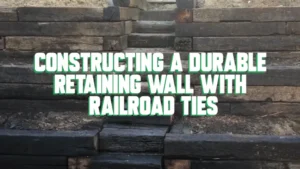




Leave your comment